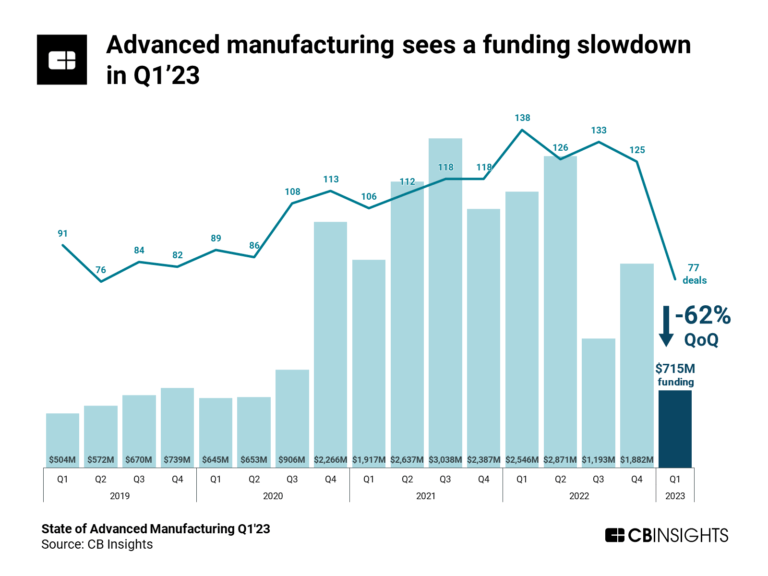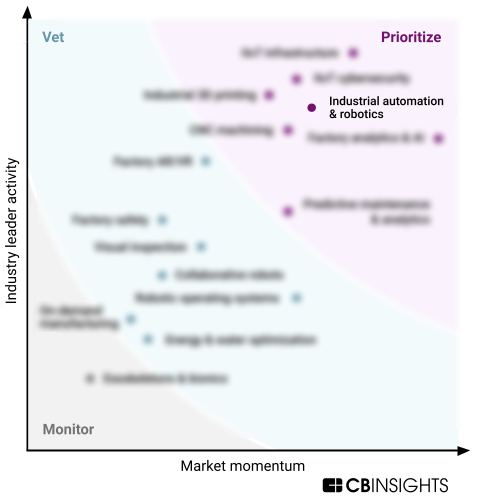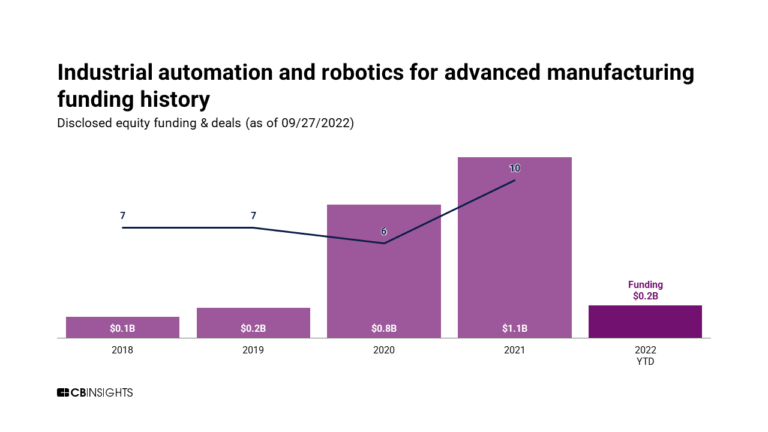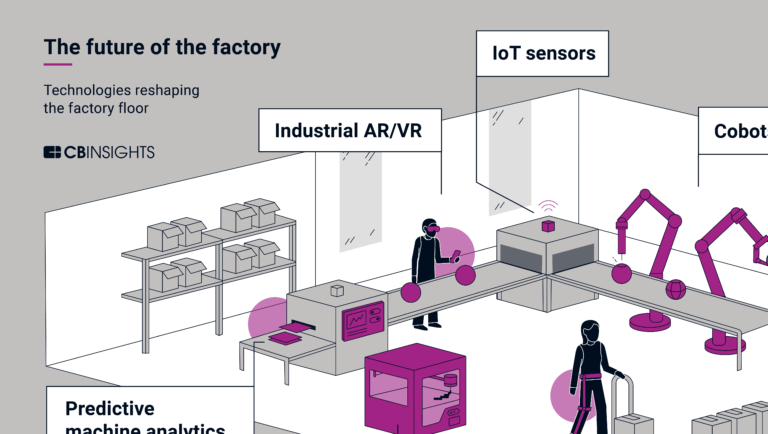
Relativity Space
Founded Year
2016Stage
Angel | AliveTotal Raised
$1.405BMosaic Score The Mosaic Score is an algorithm that measures the overall financial health and market potential of private companies.
-2 points in the past 30 days
About Relativity Space
Relativity Space operates a commercial launch company that focuses on the aerospace industry. The company specializes in providing launch services using reusable rockets and manages additive manufacturing to reduce vehicle complexity and production costs. Relativity Space primarily serves the space infrastructure sector with its launch capabilities. It was founded in 2016 and is based in Long Beach, California.
Loading...
ESPs containing Relativity Space
The ESP matrix leverages data and analyst insight to identify and rank leading companies in a given technology landscape.
The space launch systems (SLSs) market is a highly competitive and rapidly evolving space that focuses on providing launch solutions for space missions. It encompasses various companies and organizations that develop and operate launch vehicles capable of delivering payloads into space. These launch systems are designed to meet the specific requirements of different customers, including government…
Relativity Space named as Challenger among 15 other companies, including SpaceX, Boeing, and Northrop Grumman.
Loading...
Research containing Relativity Space
Get data-driven expert analysis from the CB Insights Intelligence Unit.
CB Insights Intelligence Analysts have mentioned Relativity Space in 4 CB Insights research briefs, most recently on May 4, 2023.


Jun 23, 2022 report
Why advanced manufacturers are prioritizing industrial automation & roboticsExpert Collections containing Relativity Space
Expert Collections are analyst-curated lists that highlight the companies you need to know in the most important technology spaces.
Relativity Space is included in 7 Expert Collections, including Unicorns- Billion Dollar Startups.
Unicorns- Billion Dollar Startups
1,258 items
Game Changers 2018
70 items
Future Unicorns 2019
50 items
Advanced Manufacturing
6,494 items
Companies in the advanced manufacturing tech space, including companies focusing on technologies across R&D, mass production, or sustainability
Aerospace & Space Tech
3,471 items
These companies provide a variety of solutions, ranging from industrial drones to electrical vertical takeoff vehicles, space launch systems to satellites, and everything in between
Defense Tech
737 items
Defense tech is a broad field that encompasses everything from weapons systems and equipment to geospatial intelligence and robotics. Company categorization is not mutually exclusive.
Relativity Space Patents
Relativity Space has filed 8 patents.
The 3 most popular patent topics include:
- 3d printing
- 3d printing processes
- actuators

Application Date | Grant Date | Title | Related Topics | Status |
|---|---|---|---|---|
11/26/2019 | 2/16/2021 | Artificial neural networks, Machine learning, Classification algorithms, Sensors, Artificial intelligence | Grant |
Application Date | 11/26/2019 |
|---|---|
Grant Date | 2/16/2021 |
Title | |
Related Topics | Artificial neural networks, Machine learning, Classification algorithms, Sensors, Artificial intelligence |
Status | Grant |
Latest Relativity Space News
Jan 20, 2025
Rosotics Shifts Focus from Metal 3D Printer OEM to Space 3D Printing-as-a-Service 3DPOD 235: 3D Printing in the FBI and More with Kevin Ayers, 3D Metal Konsulting and AMUG Printing Money Episode 25: Deals & Analysis with Arno Held (AM Ventures) and Tali Rosman Search Contact us below to learn more Rosotics Shifts Focus from Metal 3D Printer OEM to Space 3D Printing-as-a-Service Share this Article Rosotics —formerly a Mesa, Arizona-based startup dedicated to manufacturing and selling large-format metal 3D printers—has announced a significant restructuring that involves not only a change in location but also go-to-market. The startup, which develops induction-based metal additive manufacturing (AM) technology, is transitioning to become a full-fledged space infrastructure company headquartered at Cape Canaveral, Florida. The company’s latest Halo platform will no longer be available for commercial sale. Instead, the system will be reserved exclusively for internal production, aligning with Rosotics’ broader ambitions of creating autonomous orbital infrastructure at the Earth-Moon L5 Lagrange point. The decision underscores a radical shift in focus for Rosotics, as outlined by founder and CEO Christian LaRosa in an interview with 3DPrint.com: “We determined the way to fund our long-term ambitions wasn’t necessarily from selling the systems; it was in using the system. Many of the big names in 3D printing, like Relativity Space, took additive manufacturing and applied it to their unique goals. For us, it’s about using this platform to drive our mission forward.” AM-as-a-Service: A Strategic Pivot Since its founding in 2019, Rosotics has operated with a mission to address the scalability challenges in metal 3D printing. The company’s hallmark achievement, the Halo platform, leverages induction heating to bypass the limitations of laser-based systems. Initially marketed to industries including aerospace, naval, and defense, Halo was described as a “supercreator” capable of manufacturing structures up to six meters in diameter. Soon, however, the company found its ultimate potential not in selling systems but in leveraging them internally. Rosotics plans to employ Halo systems to produce orbital transfer vehicles (OTVs), which will be key components of its strategy to industrialize space. The spacecraft, designed with mass-optimized 3D-printed aluminum hulls, will carry smaller autonomous vehicles to the L5 point. There, these vehicles will assemble large-scale infrastructure using an advanced process involving cold welding, a method uniquely suited to the vacuum of space. The shift to AM-as-a-service is one that we’ve seen many startups pursue, in large part because achieving proper parts requires expertise behind the 3D printing process being utilized. For instance, both Holo and 3DEO deployed their knowledge of their proprietary technologies to produce parts for others. The same rationale makes almost more sense for Rosotics, given the size and special nature of the induction metal fabrication technique. Because companies like VAST and Relativity Space have demonstrated the ability for new space startups to take on the seemingly gargantuan tasks of building hulls for spacecraft, there’s reason to believe that Rosotics can follow in their footsteps. Relocating to Cape Canaveral The decision to relocate operations to Cape Canaveral signals this same trajectory. The company aims to capitalize on the talent pool and logistical advantages offered by the area, positioning itself alongside some of the most prominent names in space exploration. LaRosa confirmed that the move is already underway and that the company is building a new facility tailored for spacecraft production and spaceflight operations. LaRosa’s vision includes creating infrastructure that can support various orbital activities, from propellant depots to power generation and materials processing. The L5 point, a region of gravitational stability between Earth and the Moon, is central to these plans. Using a low-energy lunar-assisted trajectory, Rosotics aims to establish the foundational elements of a space-based industrial ecosystem. “Cold welding is something we believe to be the missing link that has prevented the large-scale architecture of heavy infrastructure in orbit,” LaRosa explained. The process, which joins metals without heat by exploiting the absence of atmospheric oxides in space, will be used by Rosotics’ autonomous spacecraft to build massive aluminum structures comparable in size to the International Space Station or larger. Leadership Changes and Strategic Partnerships Rosotics is also undergoing internal changes to support its refocused strategy. Co-founder and COO Austin Thurman has departed the company. While LaRosa described the departure as amicable, he noted that the transition marks a new chapter for Rosotics. “Austin found this to be the right point to pursue his own professional journey,” LaRosa said. “We wish him the best as we aggressively push forward toward flight.” Despite exiting the maritime sector directly, Rosotics plans to maintain an indirect presence by licensing its technology to partners in that space. “This isn’t about closing doors; it’s about opening others that we haven’t been able to before,” LaRosa stated. “By equipping adjacent partners to serve these markets under their own name, we can focus more intensively on aerospace.” Rosotics’ lean operational model has been key to its progress. With just $2.6 million in funding, including backing from Tim Draper and other notable investors, the company has achieved significant technological milestones. LaRosa attributes this efficiency to its origins in Mesa, Arizona, far from the costlier hubs of aerospace innovation. While the company intends to raise additional capital, LaRosa emphasized that the revenue generated by licensing Halo technology and future space-based services will play a crucial role in sustaining its ambitions. “This is not something you could have done on just investment,” he said. “You need stability of finance and of revenue. Halo is the platform that will, by proxy, fund our plans to industrialize space.” Pioneering a New Frontier Rosotics’ roadmap includes the deployment of integrated spacecraft within 12 to 18 months, with a timeline of two to three years for orbital operations. The company’s vision positions it as a pioneer in a rapidly evolving industry, leveraging additive manufacturing not as an end but as a means to redefine what is possible in space exploration and infrastructure development. Rosotics has always operated at the intersection of additive manufacturing and ambitious engineering. The Halo platform, described by industry insiders as “the most advanced, complex metal additive process ever devised,” exemplifies this ethos. By taking its technology in-house and focusing on space, the company aims to join the ranks of transformative entities like Relativity Space and SpaceX. LaRosa’s conviction is clear: “We are now defining ourselves as a space company built on the hallmark of 3D printing. This is an inflection point for us, and we intend to finish this mission aggressively over the coming years.” Subscribe to Our Email Newsletter Stay up-to-date on all the latest news from the 3D printing industry and receive information and offers from third party vendors. Enter your email address* This field is for validation purposes and should be left unchanged.
Relativity Space Frequently Asked Questions (FAQ)
When was Relativity Space founded?
Relativity Space was founded in 2016.
Where is Relativity Space's headquarters?
Relativity Space's headquarters is located at 3500 East Burnett Street, Long Beach.
What is Relativity Space's latest funding round?
Relativity Space's latest funding round is Angel.
How much did Relativity Space raise?
Relativity Space raised a total of $1.405B.
Who are the investors of Relativity Space?
Investors of Relativity Space include Eric Schmidt, K5 Global Technology, Consus Asset Management, NH Investment & Securities, Hanwha Aerospace and 36 more.
Who are Relativity Space's competitors?
Competitors of Relativity Space include SpaceX and 7 more.
Loading...
Compare Relativity Space to Competitors

Exos Aerospace specializes in the development of reusable space launch vehicles within the aerospace industry. The company offers commercial spaceflight services with a focus on providing customers with access to space for microgravity experiments and payload deployment. It primarily serves sectors that require suborbital technology demonstrations and research in biological, pharmaceutical, medical, and space manufacturing fields. It was founded in 2014 and is based in Greenville, Texas.

United Launch Alliance specializes in space launch services, providing reliable access to space with a focus on advanced rocket technology. The company offers a range of rockets, including the next-generation Vulcan, as well as the Atlas V, Delta IV, and Delta II, which are designed to deliver payloads into orbit with precision and reliability. United Launch Alliance primarily serves the needs of commercial spaceflight, national defense, and scientific research sectors. It was founded in 2006 and is based in Englewood, Colorado.

SpaceX specializes in the design, manufacture, and launch of advanced rockets and spacecraft. Its main offerings include the development of launch vehicles and spacecraft that facilitate cargo resupply missions to the International Space Station, as well as initiatives aimed at enabling human spaceflight and interplanetary travel. It primarily serves governmental space agencies and the commercial satellite industry. It was founded in 2002 and is based in Hawthorne, California.
Orbital ATK is a company focused on aerospace and defense, providing systems and services for space-related applications. The company offers a range of products including space launch vehicles, satellite components, and missile defense systems. Orbital ATK serves various sectors including government and commercial space and defense markets. Orbital ATK was formerly known as Orbital ATK. It was founded in 2015 and is based in Dulles, Virginia. Orbital ATK operates as a subsidiary of Northrop Grumman.
Pythom Space focuses on human space exploration within the aerospace industry. The company develops a complete space transportation system, including reusable rockets, spaceships, and landers designed for orbital and interplanetary missions. Pythom Space's offerings cater to the needs of satellite launch services and in-space manufacturing. It was founded in 2020 and is based in Bishop, California.

Blue Origin specializes in aerospace and spaceflight services, focusing on controlling the cost of access to space. It designs and manufactures reusable rocket engines, launch vehicles, in-space systems, and lunar landers to facilitate space exploration and development. Its primary market includes government and commercial entities in the space exploration and satellite deployment sectors. It was founded in 2000 and is based in Kent, Washington.
Loading...

